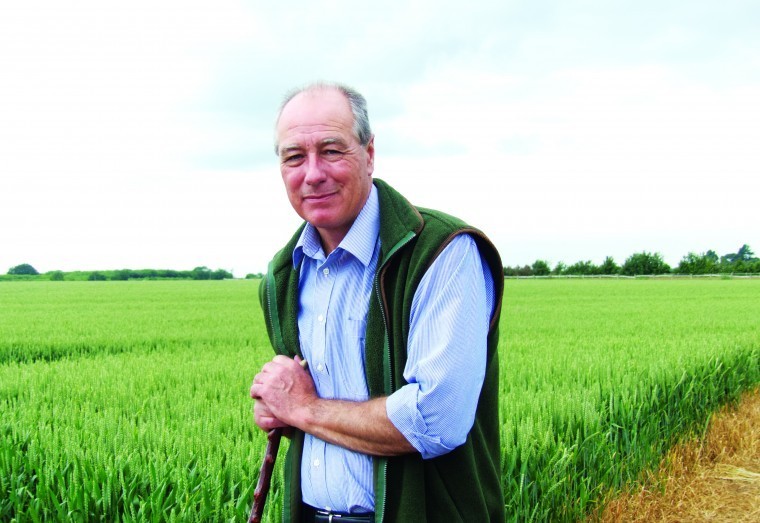As of 20 April the dominant factor is the cold and wet spring.
We still seem to be getting above average monthly rainfall, month after month and the ground in Kent is still very wet. Every time we get 13 millimetres of rain, field capacity is reached with standing water on top of the ground and seven days drying is required before much can be done. With the exception of a few warm days it is also very cold – not just air temperatures but ground temperatures as well, so growth of everything is slow. Morning frosts and cold nights just keep the pigeons keen.
It is without doubt getting late but whether the calendar is the correct arbiter or we should judge timing by temperature and crop growth is difficult to decide. Eventually growth stages in wheat will align with the calendar date so temperatures as well as rainfall will have to change.
The oilseed has without doubt suffered a prolonged onslaught from pigeons with large areas losing the main flower stem and most of the secondary side shoots.
In some places a thin single central stem with no flower bud is running up with little else in the way of vigorous growth and that does not bode well for the eventual yield. We have tended towards a two spray fungicide strategy at flowering for some years due to our relatively tight oilseed rape rotation. We have started the early flower spray but it really is pick the forward fields with others adjoining some days or weeks away.
Currently flowering would look to be very prolonged and with periodic rain in the forecast as soon as temperatures permit, we can expect schlerotia germination at the monitoring sites and in our fields. Keeping fungicide cover may well be a challenge as well as assessing the economic return from repeat sprays.
Wheat crops have all had a very robust T0 fungicide spray at the right growth stage and in good conditions. We sacrificed the timing of Pacifica and Broadway Star applications for residual grass weeds to get disease control started. In the gap in timing between T0 and T1 we have cleared up the outstanding grass weed sprays. What level of control they achieve will be interesting to see but these days it is always a lottery anyway.
On the whole I am encouraged by our wheat crops on the North Downs. The heavy soils of the north Kent marshes and the Weald are another matter. Despite timely applications of nitrogen many are seriously thinned by the wet weather and slow to grow away. In due course those soils will dry out and crack open on the way to turning into bricks which will test what roots those crops have put down during the wet autumn winter and spring.
That brings me to spring drilling. Most has been done over the past month in the dry spells but little of it has gone in well and some still needs to be completed. To set the scene one block of Weald clay that we farm has been wet since mid September when we nearly got a combine stuck and there has not been an opportunity to drill it with anything since then, which is more than seven months. As we have kept drilling the best fields at every opportunity finally we are left with that one block of 40 hectares.
As we near the end of April the question is should we bother or fallow it and spend some time controlling the resistant black grass problem. It really is a decision to take with reluctance but drilling late now will lead to a later harvest and a cycle that will repeat in the autumn when we will be struggling to cut a crop and achieve a seed bed before it rains again. Perhaps better to ensure a good start for a winter wheat crop with a lower black grass pressure. It just goes against a farmer’s natural instincts and the intention not to let the weather beat us.
As one would expect, what has been successfully drilled is very slow to emerge with plenty of hungry rooks to greet it as it struggles through. Overall spring barley is showing a reasonable plant with later drillings rapidly catching up with the earlier ones. Spring beans are emerging and subject to the attention of pea and bean weevil are encouraging. All weed control and slug control has been carried out and it really is too early to make much more comment.
I will finish with the basic payment scheme 2015 and 2016 as I am sitting wrestling with the consequence of the former and the looming deadline for the latter. We did get paid in January so no complaints on that front but it did look light. When we finally saw a claim statement it was underpaid because of an alleged over claim which translates into mapping errors on the part of the Rural Payments Agency (RPA) as they entered RLE 1 amendments onto the computer system. As we controlled all the land parcels on the 16 May 2015 and entered all of them onto the BP5 form, I find that rather galling.
Tracing the land parcels through to 2016, a number are missing which does indicate where the problem arises. But unfortunately the figures do not add up precisely between missing fields and over claim so it is no more than surmise which is a very dangerous place to be with the RPA. I really do wonder how much longer the current RPA chief executive Mark Grimshaw can preside over such a debacle and keep on making excuses without losing his job.




